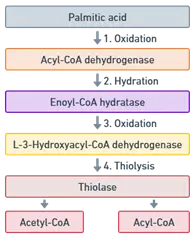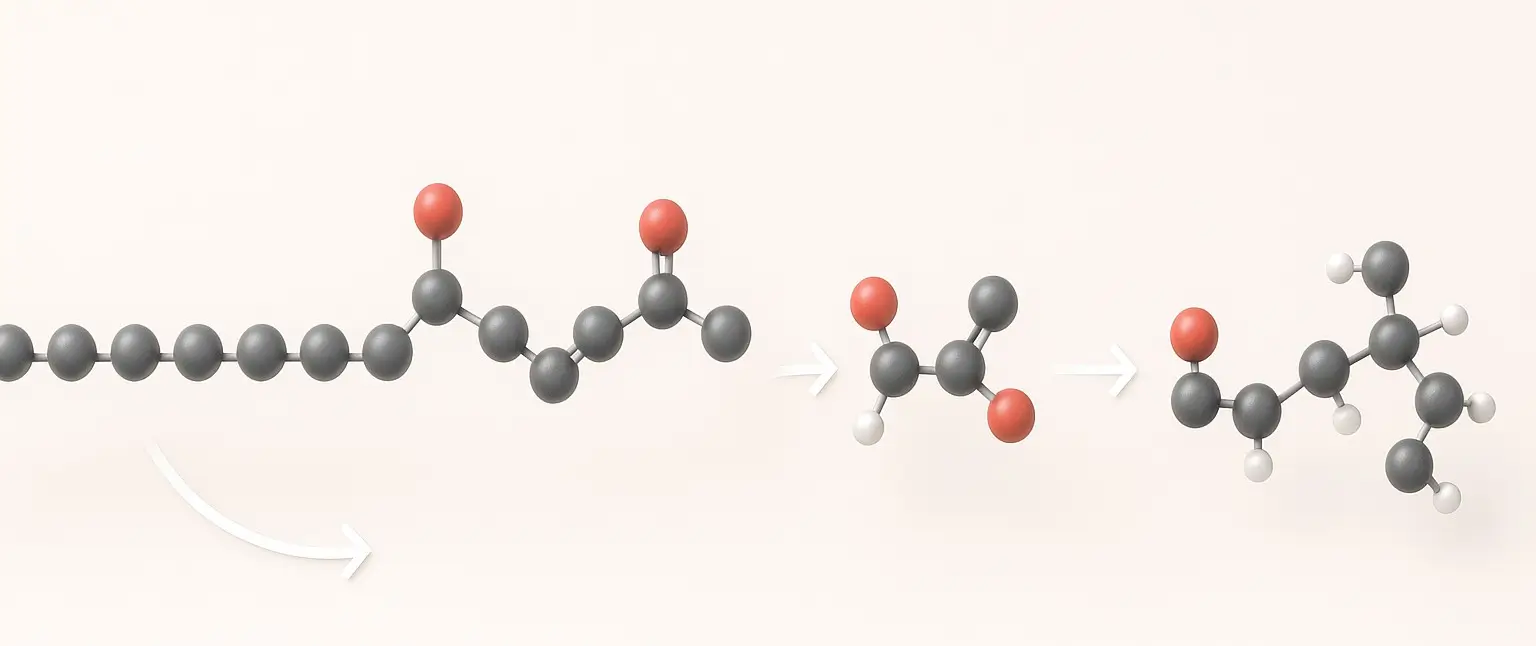- β-Oxidation is the primary pathway for breaking down fatty acids to generate energy.
- In this process, fatty acids are converted into acetyl-CoA, which enters the citric acid cycle (TCA cycle) to produce ATP.
- Here’s a detailed explanation of the beta-oxidation of palmitic acid, a saturated fatty acid with 16 carbons (C16:0).
1. Activation and Transport into Mitochondria
-
Activation:
- Process: Before beta-oxidation can occur, palmitic acid must be activated by attaching a coenzyme A (CoA) molecule.
- Enzyme: Acyl-CoA synthetase (also called fatty acid thiokinase).
- Product: Palmitoyl-CoA.
- Energy: This reaction occurs in the cytosol and consumes one ATP molecule.
-
Transport:
- Palmitoyl-CoA needs to be transported into the mitochondrial matrix for β-oxidation.
-
Step 1:
- Carnitine palmitoyl transferase I (CPT I), located on the outer mitochondrial membrane, transfers the fatty acyl group from CoA to carnitine, forming acyl-carnitine.
-
Step 2:
- Acyl-carnitine is transported across the inner mitochondrial membrane by the carnitine-acylcarnitine translocase
-
Step 3:
- Inside the mitochondrial matrix, carnitine palmitoyl transferase II (CPT II) transfers the fatty acyl group from carnitine back to CoA, regenerating acyl-CoA and releasing free carnitine.
-
- Palmitoyl-CoA needs to be transported into the mitochondrial matrix for β-oxidation.
2. Beta-Oxidation Steps
- Beta-oxidation consists of a series of four enzymatic reactions that are repeated until the entire fatty acid chain is broken down into acetyl-CoA units.

β-Oxidation of saturated fatty acid (Palmitic acid)
-
Dehydrogenation:
- Enzyme: Acyl-CoA dehydrogenase.
- Process: The first step introduces a double bond between the α (alpha) and β (beta) carbons of the fatty acid chain.
- Products: Formation of trans-enoyl-CoA and reduction of flavin adenine dinucleotide (FAD) to FADH2.
-
Hydration:
- Enzyme: Enoyl-CoA hydratase.
- Process: A water molecule is added across the double bond formed in the previous step.
- Product: L-3-hydroxyacyl-CoA.
-
Dehydrogenation:
- Enzyme: 3-hydroxyacyl-CoA dehydrogenase.
- Process: The hydroxyl group on the β-carbon is oxidized to a carbonyl group (ketone), forming β-ketoacyl-CoA.
- Product: Reduction of NAD+ to NADH.
-
Thiolysis:
- Enzyme: β-ketothiolase.
- Process: The bond between the α and β carbons is cleaved.
- Products: One molecule of acetyl-CoA and a fatty acyl-CoA that is two carbons shorter.
3. Repetition:
- For palmitic acid (C16:0), these four reactions are repeated seven times, producing a total of eight acetyl-CoA molecules.
-
Energy Production
- TCA Cycle Entry: The acetyl-CoA molecules generated through beta-oxidation enter the TCA cycle.
- Additional Products: The TCA cycle generates more NADH, FADH2, and ATP.
- Electron Transport Chain: NADH and FADH2 produced during beta-oxidation and the TCA cycle are used in the electron transport chain to generate ATP via oxidative phosphorylation.
-

